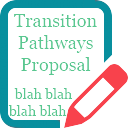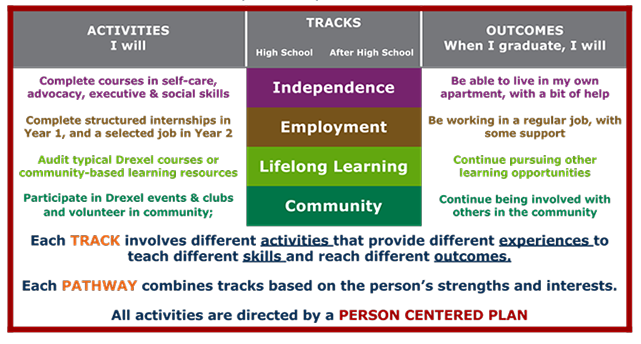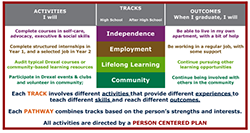Original Proposal for Transition Pathways
September 23, 2016
 In February 2016, the Life Course Outcomes Research program at the AJ Drexel Autism Institute announced the receipt of a $3.5 million gift to launch a 5-year Transition Pathways Initiative at Drexel, with the potential of an additional $9 million award later in 2016 to support a dedicated facility on campus. My immediate goal was to launch a program in September 2016 to serve at least 16 students from the Philadelphia School District. My specific, long-term goal was to demonstrate a new type of comprehensive, college transition program; the first program in the USA that is accessible to families regardless of income, and with a specific plan to expand to other sites in the region. Here are some important features of the program we proposed.
In February 2016, the Life Course Outcomes Research program at the AJ Drexel Autism Institute announced the receipt of a $3.5 million gift to launch a 5-year Transition Pathways Initiative at Drexel, with the potential of an additional $9 million award later in 2016 to support a dedicated facility on campus. My immediate goal was to launch a program in September 2016 to serve at least 16 students from the Philadelphia School District. My specific, long-term goal was to demonstrate a new type of comprehensive, college transition program; the first program in the USA that is accessible to families regardless of income, and with a specific plan to expand to other sites in the region. Here are some important features of the program we proposed.
Transition Pathways aimed to help high school graduates on the autism spectrum who are on the cusp of studying, living, or working independently. We committed to launch full-time, two-year College and Work Pathways for at least 16 students each year beginning in September 2016. Students would begin the program in their last year of high school and continue one year after leaving high school.
We proposed three phases of program expansion over the 5 year funding cycle, including the addition of a dormitory, the addition of other community partners, and an increase to serve at least 64 students each year by September 2021.
These comprehensive Pathways were designed to include opportunities for competitive employment, independent living, community engagement, and lifelong learning that could be combined flexibly depending on the individual’s strengths and preferences. These are summarized in a diagram originally published on the website of the Autism Institute when the gift was first announced (a related FAQ can be downloaded here).
I began to negotiate agreements to run these programs in partnership with the Philadelphia School District, and Community Integrated Services. I specifically designed the program to minimize if not eliminate new funding from the Philadelphia School District, and to draw on other existing or newly identified public funding sources. Our plan was to eliminate fees charged to families in the first year, and significantly reduce if not eliminate these fees in the second year. These partnerships also created the opportunity to coordinate training and policy to the benefit of all people on the spectrum served by these agencies.
The program described in the funding proposal significantly increased Drexel’s commitment to the community of people with ASD
- The campus-based internship and job opportunities provided to Pathways students was the first concerted effort to coordinate with adult service agencies to support job placements for people with autism at Drexel University
- We would create a new non-credit program to allow students with autism to audit selected university courses with support and at a reduced fee
- We would dramatically increase support for a program of peer mentors, to benefit students on the autism spectrum across campus.
Following the award of the first grant in December 2015, we were invited to submit a second proposal in May 2016 to renovate a building, at an initially projected total cost of $9 million. My goal was to:
- Include classrooms and offices for Transition Pathways, housing for 16 Transition Pathways students as part of an expanded Independent Living and Learning program, and apartments for two Residence Advisors.
- Create a funding model to bring the cost of the Independent Living and Learning Program within the reach of all families.
Note that the descriptions offered here reflect the plans I had outlined for the program prior to my decision to resign from Drexel in February 2016, and so may not be integral to the program that is ultimately implemented.











